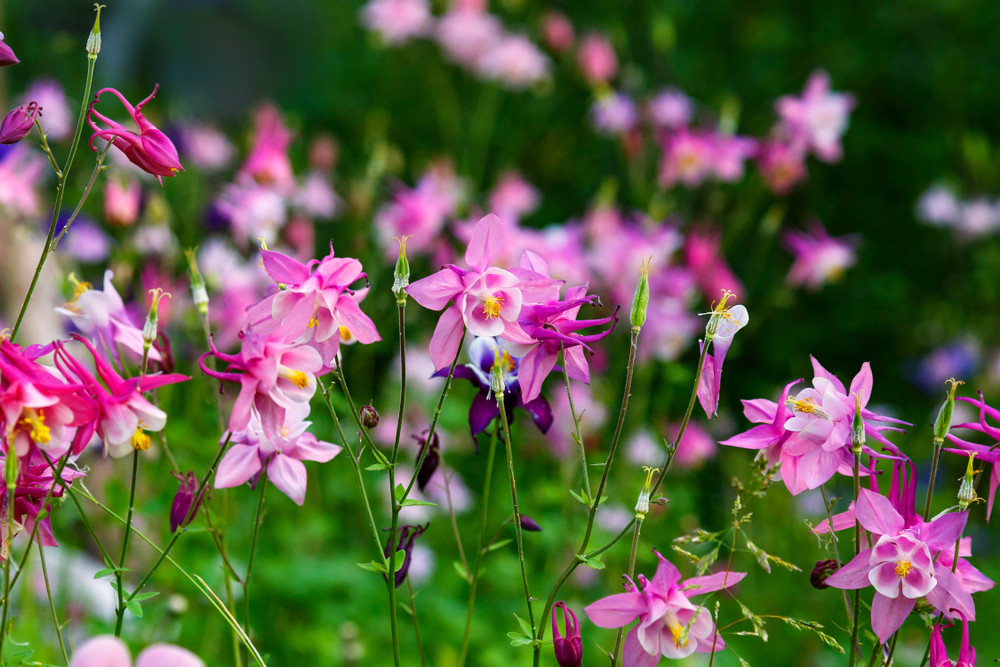
In almost every garden, you will find at least one area that lies in the shade.
It could be under a beautiful tree in a very prominent part of the garden or in a faraway nook that doesn’t draw much attention.
Sometimes you can increase light by trimming overhead branches or reducing the height of the hedges, but that may not always be the case.
Depending on the position of your front garden and backyard with respect to your house, there will be areas that come in the shade of the house or garage during most part of the day.
You may not be able to do much to change the situation.
Other unchangeable shady areas occur between the house and the garage or close to the garden wall or fence separating your property from the neighbor’s.
It is a challenge to keep shady areas in the garden attractive.
Painting the walls white may help brighten up the spaces in permanent shade, but that doesn’t solve the problem. You need to choose the right plants to liven up the area.
Turn to nature for inspiration where every nook and corner is filled with rich vegetation.
What grows in densely shaded forest floors and along the edges of woods would be happy to grow in your shade garden.
Here’s a good selection of shade loving perennial plants to beautify your problem areas.
1. Astilbe – USDA zones 3-9
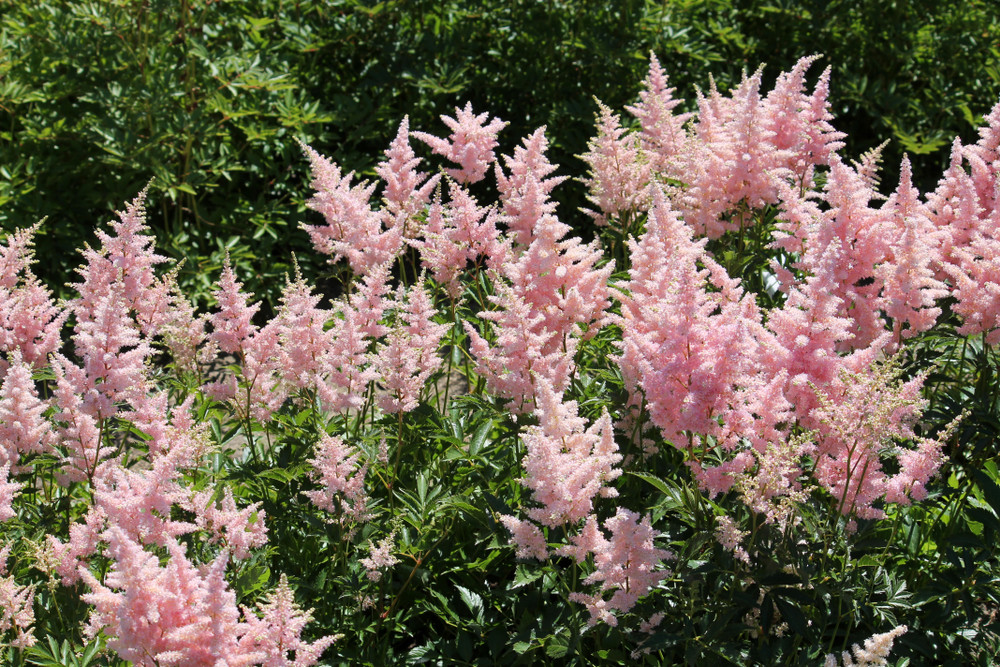
Being one of the easiest perennials for shade, astilbe is the first choice to add color to a shady spot.
With its glossy, fern-like foliage, the plant provides year-round interest, except in winter. But the plume-like flower heads held high above the foliage are real show stoppers.
The flower spikes give astilbe common names such as false spirea and False Goat’s beard.
The color choices mainly lie in the pink spectrum, but you also have white and red-flowered astilbes. The flower heads last for several weeks, and can be cut for a beautiful arrangement to adorn your table.
Astilbes are usually grown from divisions which are planted in spring or summer in rich, moist soil.
Keep the divisions evenly moist.
These plants need a light cropping after all the flowers are spent. This will keep the plant neat through fall and until the leaves start yellowing at the approach of winter.
2. Bergenia – USDA Zones 4-10
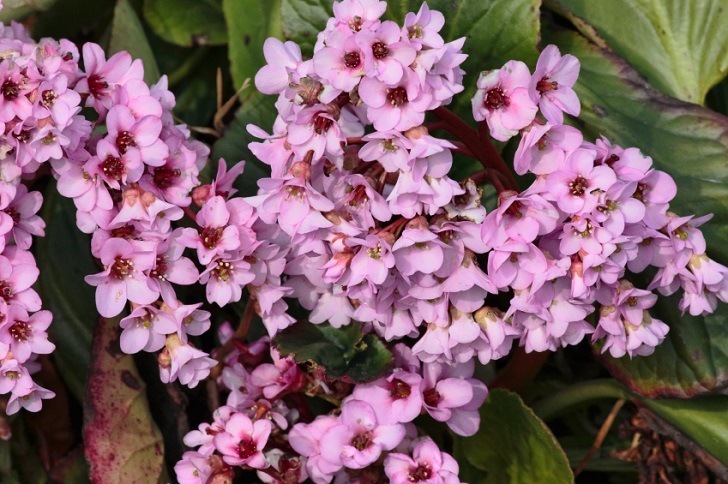
These low-growing plants from central Asia have large, glossy green leaves that either remain green or display red fall colors, usually in colder regions.
They are great for shade gardens, especially as borders or for growing under trees.
The flowers are small and bell-shaped, but they appear in clusters which are held above the foliage on 1 ft long stalks.
Pinks and purples are the usual flower colors, but you can find nearly white and ruby red varieties too.
You can grow bergenia from divisions taken after they finish blooming.
Older plants start dying out in the center, so you know when it’s time to divide your existing stock. These plants need rich, moist soil to thrive.
They do best in partial shade, but full sun can burn the leaves, so provide shade if they are planted under deciduous trees that shed their leaves completely.
3. Black cohosh/Black snakeroot – USDA Zones 3-8
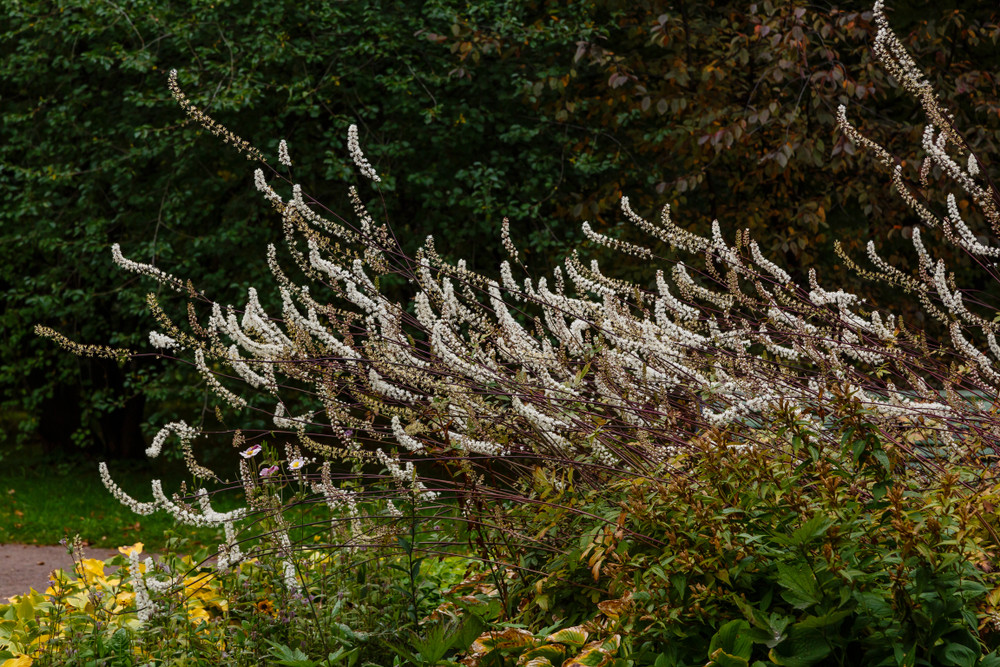
This native woodland plant preferring shade and moist soil has attractive, deeply cut leaves similar to astilbes.
Fuzzy spikes in white appear in summer, and they are held well above the foliage. The flowers may have an unpleasant odor, which gives this plant its common name, bugbane.
This plant can be grown from seeds, but usually, divisions are used. Plant them in spring in partial shade and keep the soil moist.
The plants are clump-forming, and may grow 3ft to 6 ft tall, so choose the cultivars and location carefully.
4. Columbines – USDA Zones 3-8
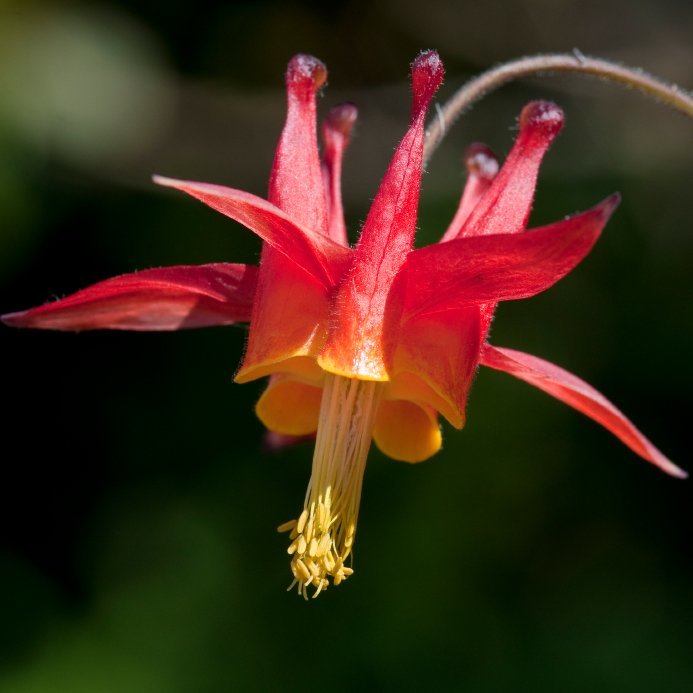
The bell-shaped nodding flowers of aquilegia make this plant a beautiful addition to any garden.
These small-leaved plants make great companions for other large-leaved plants in the shade garden such as hostas.
The flowers appear in late spring to early summer, each one consisting of 5 petals and five sepals. The contrasting and complimentary colors of petals and sepals make interesting color combinations.
They are a favorite of bees and hummingbirds.
You can grow columbines from seeds sown in spring. These short-lived perennials decline after 3-4 years, although self-seeding usually keeps your established stands going for several years.
But it helps to collect some seeds every year for fall or spring sowing. The plants may grow 3 ft tall, but the dwarf varieties remain under 6 inches.
5. Goat’s beard – USDA zones 3-8
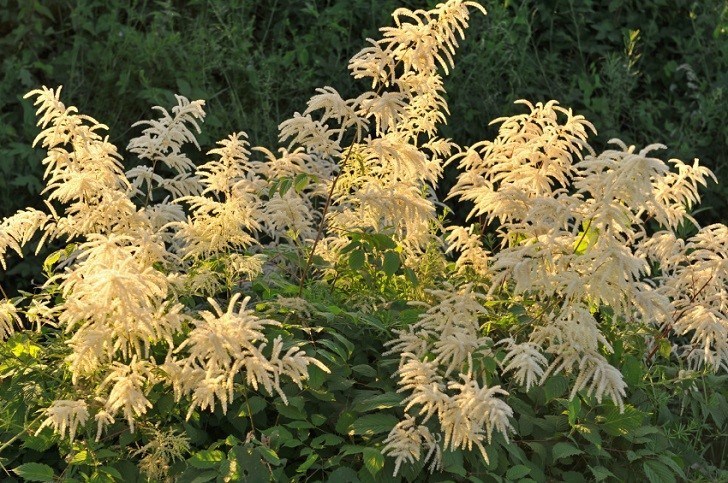
Goat’s beard is an astilbe-like perennial plant which loves the cold and damp conditions of shady woodland areas.
If you have a large area to brighten up, the enormous, creamy white flower spikes of goat’s beard will do just that.
Coming out in great profusion early and mid-summer, they are great as cut flowers and can be dried for everlasting bouquets. The deep green leaves of goat’s beard are lacy, and the plant has a dense habit.
You can grow this plant from seeds or divisions planted in spring or fall.
It self-seeds under favorable conditions. Since each clump can grow between 3ft to 5ft in height as well as width, the planting spot should be chosen with care.
Male plants are preferred for their dense, astilbe-like plumes. Female plumes are slender and pendulous.
6. Lily of the Valley – USDA Zones 2 to 9
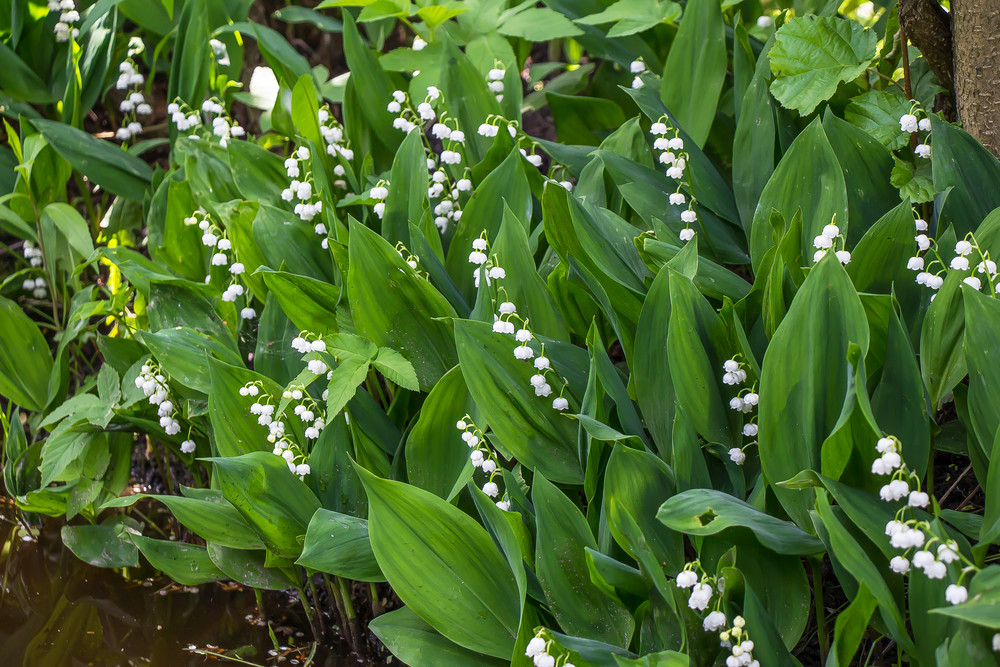
Lily of the valley is grown in shade gardens for its fragrant, bell-shaped flowers that appear in spring.
They are perfect for the shaded area under trees, where they will spread between the roots, filling up the whole space in time.
The plants have a neat habit and they never grow above 1 ft high, so you don’t have to do any pruning to keep it in check.
Lily of the valley is grown from underground stems called pips.
You can collect the pips anytime after the spring flowering period is over, but they are ideally divided and planted in fall when the plant is in dormancy.
Handle the pips with care as they are poisonous to people and pets, like every other part of the plant.
Provide sufficient moisture to young plants by covering them with a layer of mulch.
7. Japanese forest grass – USDA Zones 5-9
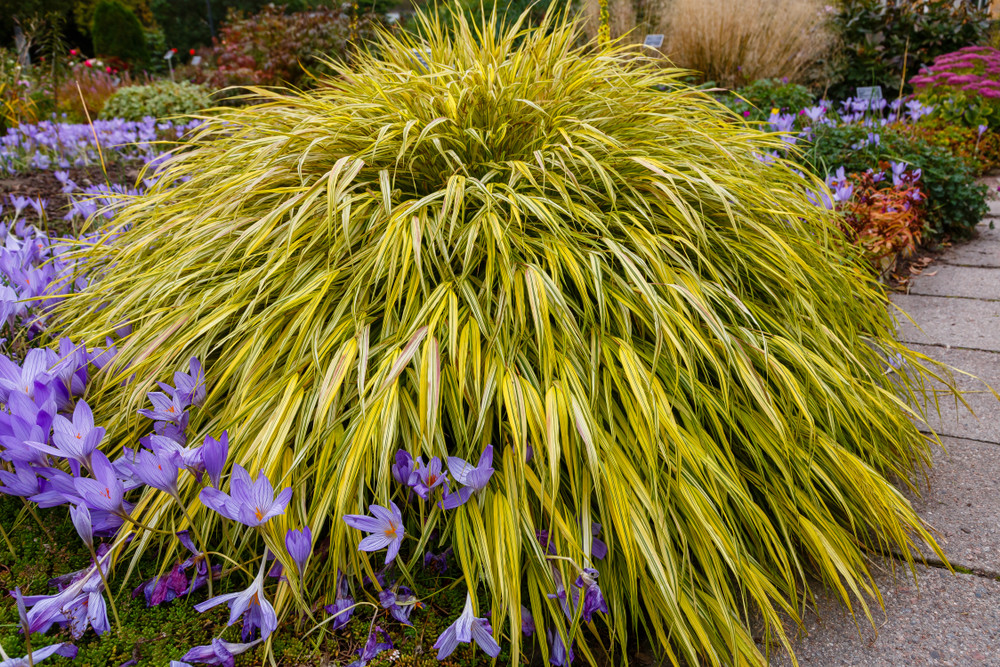
Japanese Forest grass is a perennial grass with a flowing habit, ideal for shade gardens.
There are different forms with variegated leaves, some even having attractive fall coloration.
The bright yellow foliage of the golden variety can liven up even the deepest shade. The narrow foliage contrasts well with large-leaved shade plants like hosta.
This grass can be easily propagated by dividing mature clumps.
Dig up an older plant in spring and divide it into 2-3 portions. This can be done in fall too. Plant each division, giving it plenty of space to spread.
Japanese forest grass is made for shade. In fact, the plants suffer when exposed to bright sunlight, the tips of the leaf blades becoming brown.
So give them a shady, moist spot that closely resembles their natural habitat. This grass can be trimmed to its crown occasionally to control its size and spread.
Japanese forest grass is ideal for, but can be grown in zone 4 with some extra protection and heavy mulching.
8. Coral bells – USDA Zones 3-9
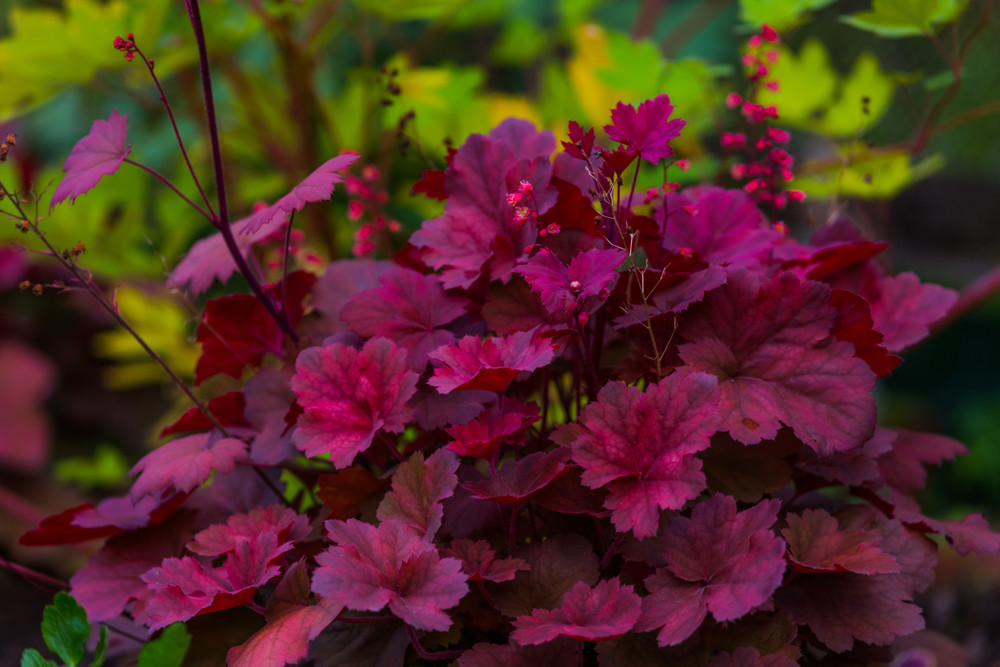
These North American natives are true evergreen perennials, keeping their leaves even under snow cover.
Original plants have green foliage, but you can get so many different varieties now, sporting colorful and variegated leaves.
The flowers are tiny, but the highly branched inflorescence is quite impressive, and makes good cut flowers.
Coral bells can be grown from seeds, but it is a time consuming process that gives uncertain results.
It is better to get ready made plants that you can plant out in the garden in spring. Divide older plants in spring to prevent them from dying out in the center.
Deadhead the flowers periodically to keep the plant in good health. Coral bells do equally well in sunny spots as well as shade.
9. Hosta – USDA Zones 3-9
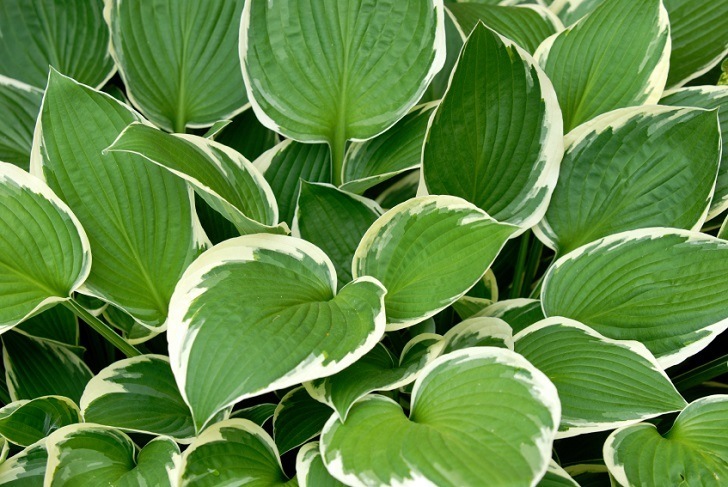
No shade garden can be without hosta. These beautiful foliage plants come in a variety of large, attention-grabbing leaves that make a weed-suppressing carpet over the ground.
The light requirement of different cultivars varies, but generally, those with lighter leaves and variegation require relatively more sunlight than the deep green varieties.
Hostas can be divided in spring, summer and fall.
Summer divisions should be watered well to prevent their drying out. Fall divisions should get enough time, at least, 4 weeks, to get established before the ground freezes over.
The planting spot should be well prepared with plenty of humus and long-release fertilizers before planting.
Hostas do need your attention. They are prone to deer and slug attack since they find its soft, fleshy leaves delicious.
Too much water, especially during the dormant season, can cause crown rot that can be devastating.
10. Pachysandra – USDA Zones 4-7
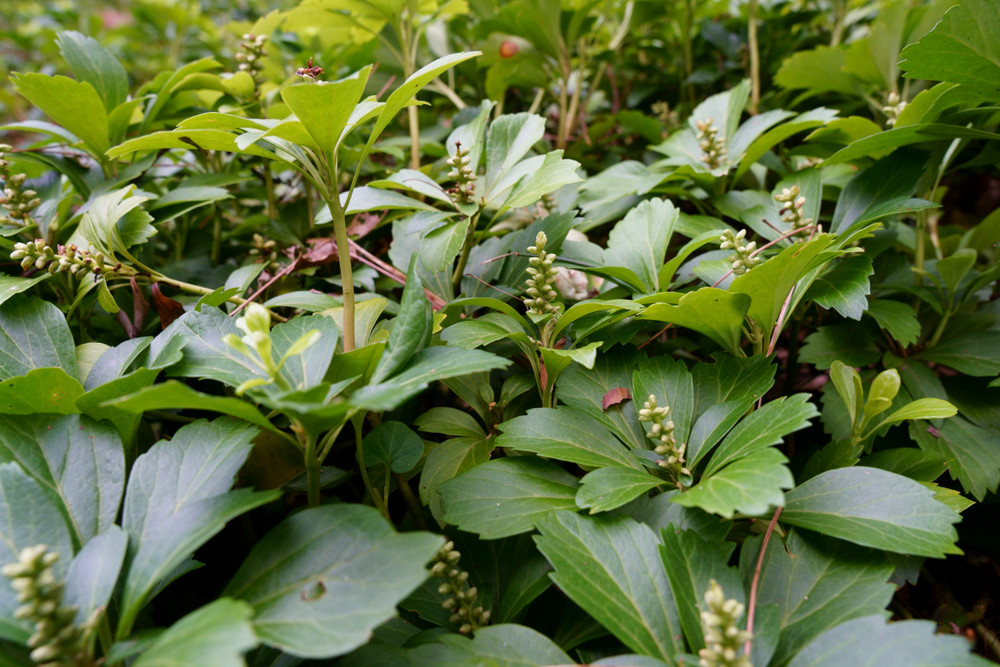
Pachysandra is a hard to ignore groundcover for shady areas, especially because it thrives in acidic soil usually found under trees.
The thick, spreading growth literally suffocates all other competition, so you will have a weed-free patch where pachysandra establishes itself.
The tiny flowers that appear in spring may not be very showy, but they have a lovely fragrance to compensate for this.
Pachysandra can be propagated from divisions, or you can get flats from the garden center when you want to cover large areas.
Plant them 1 ft apart to allow for their spread. Keep the area shaded and the soil moist until the new plants are well established.
11. Pulmonaria – USDA Zones 4-8
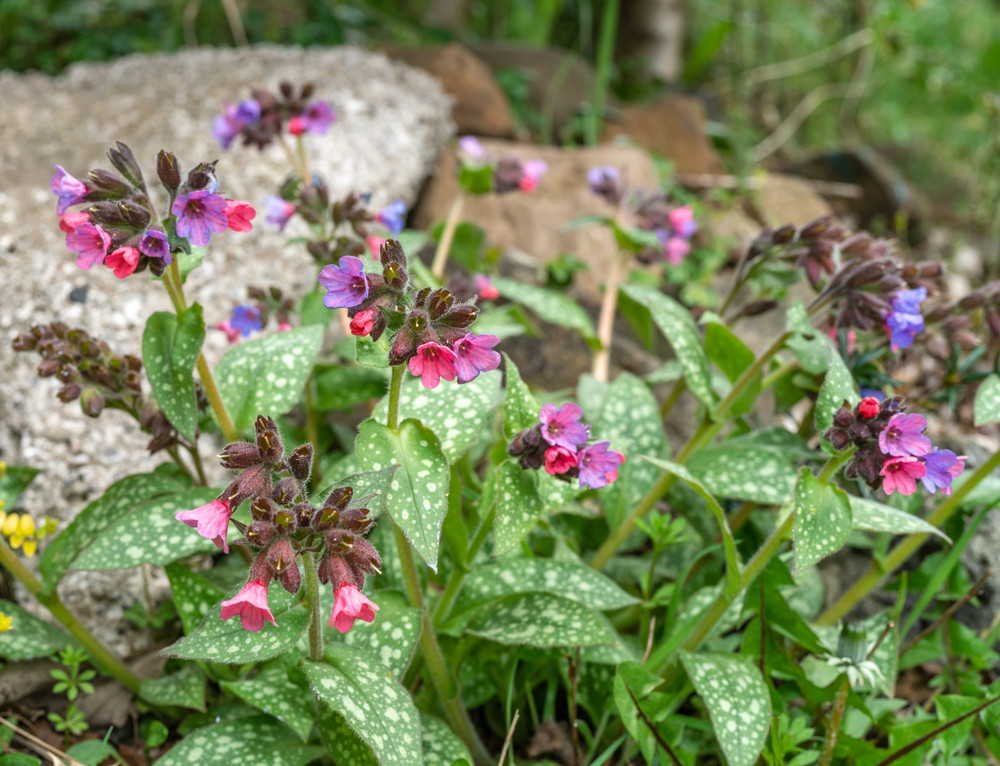
If you want a plant with both flower and foliage interest for your shady areas, the low-growing pulmonaria would be the answer.
The leaves are quite decorative, with splotches of color.
The flowers are small but come in bunches of bright pinks, purples and blues. White flowered varieties are also available.
You can grow them from seeds or divisions of underground rhizomes. Plant them in a shaded spot with other shade-lovers like hostas to add a dash of color.
Each plant will have a spread of 1 to 1 ½ ft, so space them accordingly. Keep the soil moist with regular watering.
Another problem that you may come across in the garden, especially in the outermost areas, is dry shade.
Light and water are the two most important factors for plant growth, so when both of these are denied, plants find it extremely hard.
Fortunately, we do have some plants that can survive such inhospitable conditions.
12. Lamium – USDA Zones 4-8
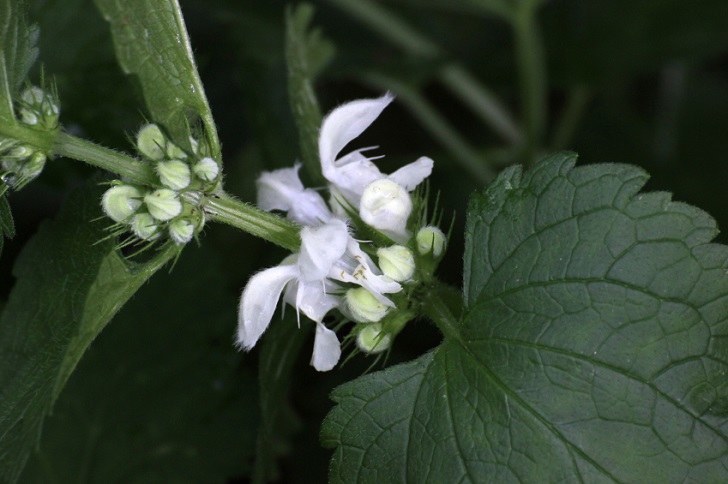
Commonly called deadnettle, this herbaceous perennial forms a delightful groundcover in shady areas, brightening up dark corners with its silvery foliage.
The pink and purple flowers are an added bonus. Some cultivars have white flowers too.
Growing not more than 6 to 8 inches tall, the plants form a neat mat over the ground, under trees and around large shrubs.
You can choose from a wide selection of flower and foliage combinations.
Keep the young plants regularly watered. Older plants can withstand occasional droughts, but water stress turns the edges of leaves brown.
13. Lilyturf – USDA zones from 5 to 10
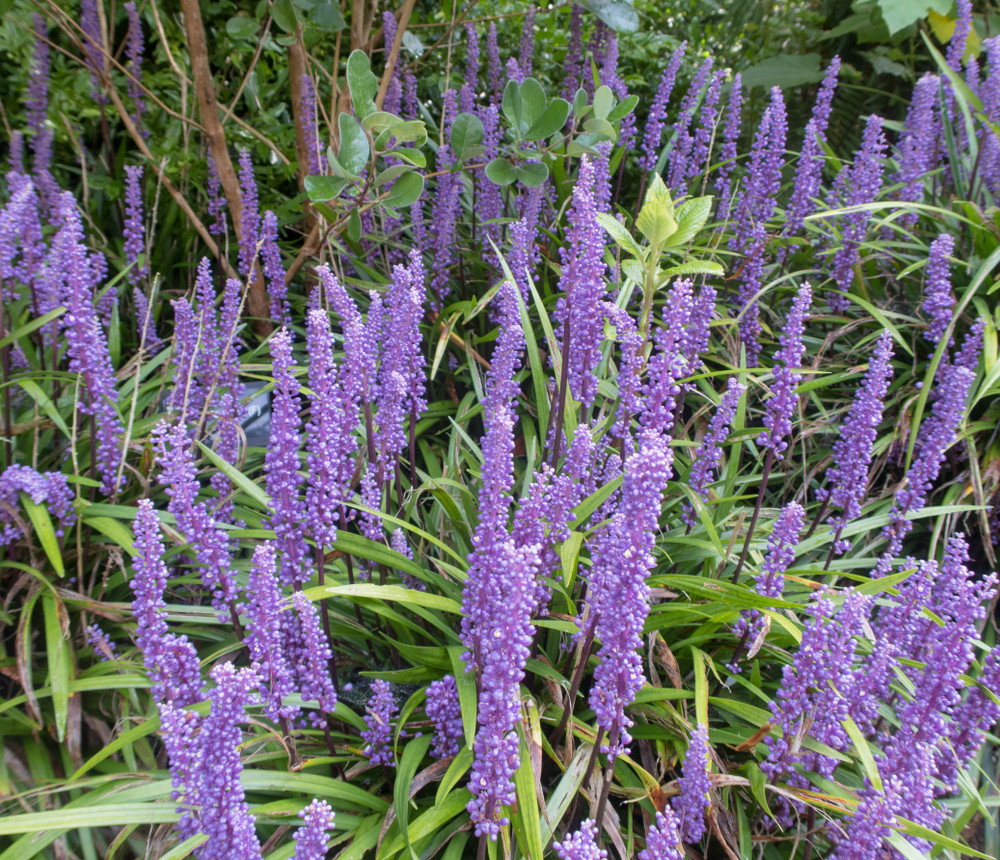
Lilyturf is another perennial with long and narrow arching leaves. It is famously easy to grow and maintain, and make good border and groundcover for shaded and dry areas in the garden.
You can get solid dark green lilyturf as well as variegated varieties.
The flowers that come in white and blue colors are rather small and inconspicuous, but some varieties have showy flowers that create good effects in massive plantings.
Lilyturf is propagated by divisions of the clump.
It is ideally done in spring in colder regions, but divisions can be done any time of the year in warmer areas.
It appreciates regular watering initially, but can withstand drought and dry heat to a great extent once the clumps are established.
14. Japanese Yellow Rose – USDA Zones 4-9
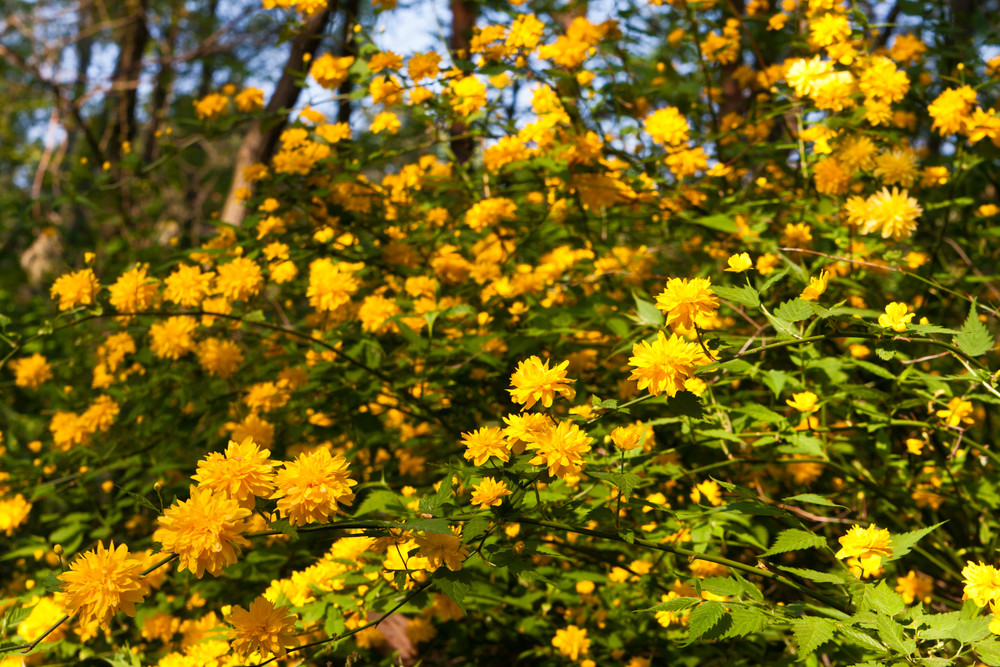
This shade-loving shrub with bright yellow flowers deserves to be more popular despite its non-native status.
This is a rose-relative devoid of thorns, as well as the fussiness of roses, making it great for low-maintenance landscapes.
The bush flowers profusely all through summer even in deep shade.
You get plants that have single layered flowers that resemble old-fashioned roses while the double layered flowers look like chrysanthemums.
The bright green serrated leaves and the green branches look good even when there are no flowers. There are variegated cultivars too.
Kerria seems to prefer poor soil and thrives when neglected, a bonus for those without a green thumb! An occasional hard pruning helps maintain the bush in good form and promotes flowering.
15. Vinca – USDA Zone 4-9
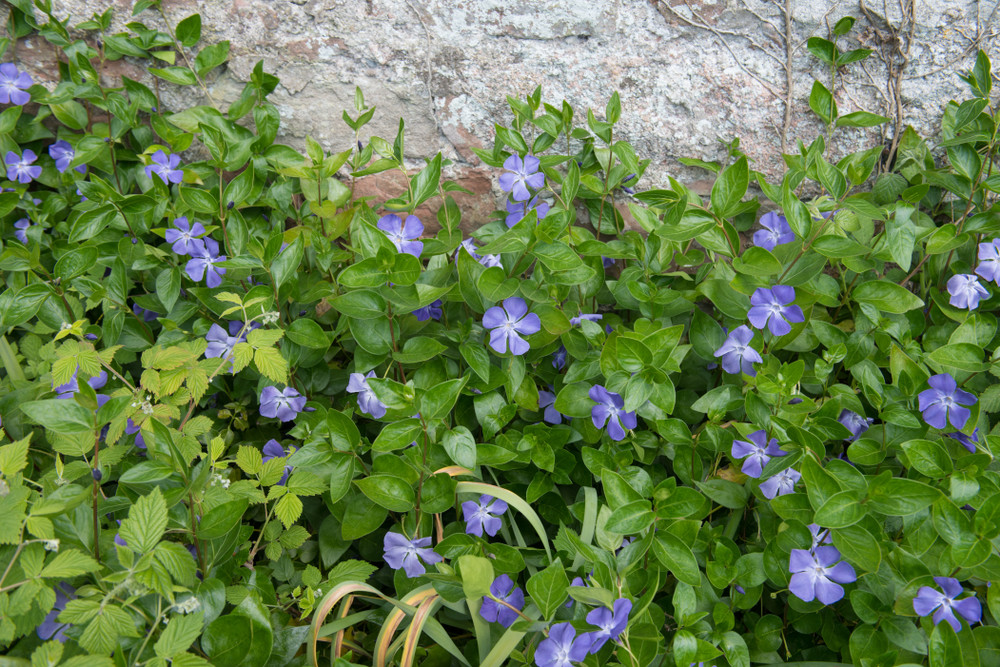
Vincas mainly come in two forms: Vinca major and Vinca minor, the former adapting well to sunny locations and hot climates. It is a perennial in USDA Zones 7-10 but treated as an annual in colder areas.
Vinca minor, commonly called dwarf periwinkle, on the other hand, prefers shade. Both types are drought-tolerant once they become established, but flowering may be affected in dry conditions.
Nevertheless, dwarf periwinkle is an excellent groundcover for dry shade, forming a thick mat that discourages other weeds.
To make a quick ground cover in a shady spot, plant Vinca minor in spring.
Set out the plants 12 inches apart to allow for their spreading habit, but a closer planting may be considered for good results.
They need regular watering initially to get established, but they can mind their own business afterward. Occasional shearing will keep the plants under control.
As you can see, there is no limit to the number of beautiful shade-loving plants you can use to adorn even the most difficult places in your garden.
